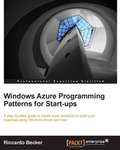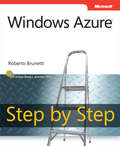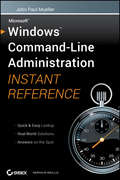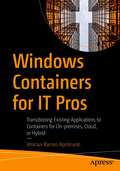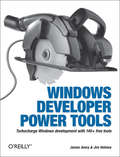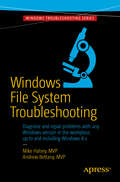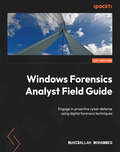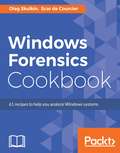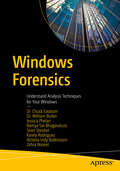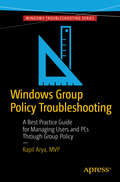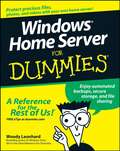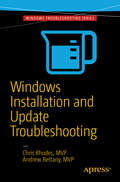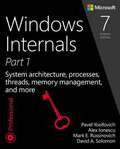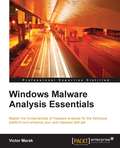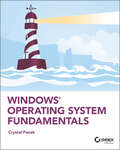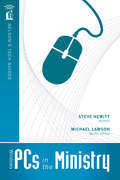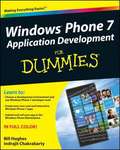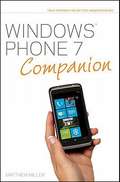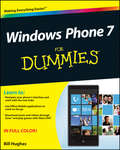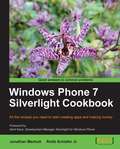- Table View
- List View
Windows Azure programming patterns for Start-ups
by Riccardo BeckerThis book follows a step-by-step approach with clear transparent instructions, screenshots and code samples. This book is intended for Microsoft .NET developers who want to leverage the power of cloud and build a brand new service from scratch; it assumes a basic understanding of the .NET framework and C#.
Windows Azure™ Step by Step
by Roberto BrunettiYour hands-on, step-by-step guide to the programming fundamentals for Windows AzureTM Teach yourself how to build and host scalable applications in the cloud using Windows Azure--one step at a time. Ideal for those with basic programming skills, this tutorial provides practical, learn-by-doing exercises for working with the core services and features of the Windows Azure platform. Discover how to: Extend your existing skills to the cloud development model Build a simple web role application and deploy it to the cloud Create a worker role project to perform backend processes Store persistent data with Windows Azure Storage Develop a scalable database application in the cloud using Microsoft SQL AzureTM Connect several cloud-based applications with Windows Azure AppFabric Design a multitiered solution that can scale to meet user demand
Windows Command-Line Administration Instant Reference
by John Paul MuellerThe perfect companion to any book on Windows Server 2008 or Windows 7, and the quickest way to access critical information Focusing just on the essentials of command-line interface (CLI), Windows Command-Line Administration Instant Reference easily shows how to quickly perform day-to-day tasks of Windows administration without ever touching the graphical user interface (GUI). Specifically designed for busy administrators, Windows Command-Line Administration Instant Reference replaces many tedious GUI steps with just one command at the command-line, while concise, easy to access answers provide solutions on the spot. Provides practical examples, step-by-step instructions, and contextual information Quick-reference style delivers the commands needed for managing data and the network; working with Active Directory; performing diagnostics and maintenance; and, creating batch files and scripts Covers administration for Windows Server 2008 Server Core, Windows Server 2008 (including R2), and Windows 7 Administrators can get more done in less time with CLI than they can with the standard GUI. Compact enough to keep on hand at all times, Windows Command-Line Administration Instant Reference provides administrators with a convenient, fast and simple way to use CLI.
Windows Containers for IT Pros: Transitioning Existing Applications to Containers for On-premises, Cloud, or Hybrid
by Vinicius Ramos ApolinarioThis book has everything you need to know about Windows Containers, from an IT pro and ops perspective. Containers are the next big thing in IT infrastructure. More and more, we see companies relying on Kubernetes implementations to run their workloads on-premises, in the cloud, or even in hybrid deployments. IT pros and ops teams are now faced with the challenge of getting up to speed on container architecture, knowing how it differs from virtual machines (VMs), and the best means and practices for managing their applications in containers. Windows Containers for IT Pros explores all of that, from the IT pro experience. You will approach learning about containers through the optics of an author who is accustomed to deploying virtual machines (VMs). You will learn about differences, parallel practices, use cases, and how to get started and go deep into day 2 operations. What You Will Learn Architect and deploy Windows Containers leveraging existing skills Containerize existing applications Know best practices for managing resources in Windows Containers Get comfortable moving containers to the cloud with Azure Understand the options for using containers on Azure Who This Book Is For Windows IT pros and technical professionals deploying Windows Server and server applications today, such as .NET, ASP.NET, IIS, and more. This book assumes little to no experience with scripting as readers deploy their workloads via one of the Windows UIs (Hyper-V, Server Manager, Windows Admin Center, etc.). Knowledge of VMs and infrastructure, such as clustered operating systems, is recommended but not required.
Windows Developer Power Tools: Turbocharge Windows development with more than 170 free and open source tools
by James Avery Jim HolmesSoftware developers need to work harder and harder to bring value to their development process in order to build high quality applications and remain competitive. Developers can accomplish this by improving their productivity, quickly solving problems, and writing better code.A wealth of open source and free software tools are available for developers who want to improve the way they create, build, deploy, and use software. Tools, components, and frameworks exist to help developers at every point in the development process. Windows Developer Power Tools offers an encyclopedic guide to more than 170 of these free tools to help developers build top-notch Windows software from desktop applications to web services. To help you choose the right tools for solving both common and uncommon problems you face each day, this book follows a unique task-oriented organization, laying out topics in the same order that you and your team are likely to encounter them as you work on a project. Each tool entry features a solid introduction -- a mini user's guide -- so you can get up to speed quickly and understand how to best use the tool in your environment. Inside, you'll find:A guide to more than 170 tools covering 24 unique aspects of Windows and .NET software development, with many descriptions contributed by the tools' authorsDescriptions of freely available ASP.NET and Windows Forms controls, object relational mapping systems, testing frameworks, and build and continuous integration toolsArticles on tools to help developers troubleshoot misbehaving applicationsGuides for utilities to boost productivity in the development environment as well as speeding up tasks in Windows itself"Quick pick" lists at the start of each chapter to help you find and choose the right tool for your task"At a Glance" and "In a Nutshell" summaries to help readers more quickly narrow their optionsReferences to an online book site to keep you up-to-date with new releases and featuresForewords by Mike Gunderloy (Larkware) and Scott Hanselman (http://www.hanselman.com/tools), operators of the two most popular tools sites for Microsoft developers.Also, plenty of links in each article point you to additional detail online if you wish to delve more deeply into features and functionality. This one-stop resource covers a wide range of open source and freeware tools to help you answer questions around planning, developing, testing, and rolling out great software. Best of all, they're free.
Windows Essential Business Server 2008: Administrator’s Companion
by J. C. MackinThe comprehensive, one-volume guide to deploying and managing Windows Essential Business Server 2008 for messaging and collaboration, security, data storage, support for line-of-business applications, and end-to-end network administration
Windows File System Troubleshooting
by Mike Halsey Andrew BettanyThe Windows file system is large and complex, featuring not only a huge number of essential files and folders for the Windows OS, your software and hardware, but also several different underlying file systems that manage and maintain file integrity on your disks. In this book you''ll learn how to navigate around the Windows file structure (up to Windows 8. 1), with what does what and how essential everything is. Additionally we''ll show you how to effectively manage file, folder and security permissions to ensure users get what the access they need, and no more. We''ll also show you how to repair the underlying disk file system should something go horribly wrong. What you''ll learn 1) The structure of the Windows OS file system 2) The differences between different disk file structures 3) How to manage and maintain file ownership, permissions and security 4) How to manage and maintain file system security and encryption 5) How to recover an unbootable file system Who this book is for IT Pros, Windows expert and power users and system administrators are the audience for this book. Table of Contents Chapter 1: Introducing the Windows File System Chapter Goal: A deep dive into the structure of Microsoft Windows and how it manages and arranges OS, update and software files and hardware drivers The Windows File Structure Critical Windows System Files and Folders Managing software and apps Windows hardware driver files and management Managing updates in Windows Chapter 2: Understanding NTFS, FAT and ReFS File Systems Chapter Goal: The main Windows disk file systems and structures detailed Introducing the Windows disk file systems NTFS FAT (FAT32 / exFAT) ReFS Chapter 3: Permissions, Ownership and Auditing Chapter Goal: A common issue with Windows is managing correct file permissions and ownership, this chapter is a complete guide in managing these effectively Managing file, folder and disk permissions Managing file and folder ownership Successfully auditing Windows files, folders and assets Chapter 4: Managing File Security Chapter Goal: Security is essential with PCs in the workplace and at home. This chapter will teach the reader how to effectively secure their Windows OS, software and files Managing Windows, file, folder and disk security Managing security for documents and both disk and network assets Maintaining security best-practice in Windows Chapter 5: Managing and Troubleshooting Encryption and Compression Chapter Goal: This chapter will teach the reader how to effectively manage and deploy security and compression on their files, folders and disks Using and managing Windows file compression Using and managing EFS in Windows Using and Managing Bitlocker and Bitlocker To Go Chapter 6: Troubleshooting the Windows File System Chapter Goal: The disk file system in Windows is also prone to errors, this chapter will get readers started in diagnosing and troubleshooting errors. How disk file system errors occur Common disk file system errors Diagnosing and repairing common disk file system errors Chapter 7: Booting the unbootable - Repairing the Windows Boot System Chapter Goal: If a PC won''t start it''s likely that the boot system will need to be repaired. This chapter is a complete guide on how to automatically and manually fix this in Windows Automatically repairing the Windows boot system Effecting manual repair to the Windows boot system Rebuilding a corrupt Windows boot system Chapter 8: Restoring Files and Folder Security Settings Chapter Goal: Sometimes it all goes horribly wrong and users can be locked out of just about everything. This chapter will teach readers how to manually reset the file and folder permissions on all files and documents in a safe and secure way. When might you need to universally reset permissions? Using ICACLS to reset file permissions and ownership Chapter 9: Repairing the Windows File System using a Portable OS Chapter Goal: If Windows is unbootable or the file system corrupt, a portable OS on USB Flash Drive or DVD can still be used to rescue the OS and your...
Windows For Tablets For Dummies
by Andy RathboneJust for you--Windows 8 from the tablet user's perspectiveIf you're an experienced Windows user, you don't need a guide to everything that Windows 8 can do, just to those tools and functions that work on your tablet. And so here it is. This new book zeros in on what you need to know to work best on your tablet with Windows 8. Topics include navigating the new Windows 8 interface and how it works on a touchscreen, how to safely connect to the Internet, how to work with apps or share your tablet in a group, and much more.If you're a new tablet user, you'll particularly appreciate the fresh guidance on storing files in the cloud, finding tools on the new Windows app store, and tablet troubleshooting.Focuses just on using Windows 8 on tablet devices, giving tablet users their own exclusive guide Covers unique Windows 8 tablet features, such as the touchscreen interface, the new Windows app store, cloud computing options, and tablet troubleshooting Explores using a tablet PC as a media machine for music, photos, and video, as well as how to stay safe online, improve performance, and other topics Reveals savvy, practical tips from bestselling Windows For Dummies author Andy RathboneKeep Windows 8 For Tablets For Dummies close at hand and get the very most out of your Windows 8 tablet.
Windows Forensics Analyst Field Guide: Engage in proactive cyber defense using digital forensics techniques
by Muhiballah MohammedBuild your expertise in Windows incident analysis by mastering artifacts and techniques for efficient cybercrime investigation with this comprehensive guideKey FeaturesGain hands-on experience with reputable and reliable tools such as KAPE and FTK ImagerExplore artifacts and techniques for successful cybercrime investigation in Microsoft Teams, email, and memory forensicsUnderstand advanced browser forensics by investigating Chrome, Edge, Firefox, and IE intricaciesPurchase of the print or Kindle book includes a free PDF eBookBook DescriptionIn this digitally driven era, safeguarding against relentless cyber threats is non-negotiable. This guide will enable you to enhance your skills as a digital forensic examiner by introducing you to cyber challenges that besiege modern entities. It will help you to understand the indispensable role adept digital forensic experts play in preventing these threats and equip you with proactive tools to defend against ever-evolving cyber onslaughts. The book begins by unveiling the intricacies of Windows operating systems and their foundational forensic artifacts, helping you master the art of streamlined investigative processes. From harnessing opensource tools for artifact collection to delving into advanced analysis, you’ll develop the skills needed to excel as a seasoned forensic examiner. As you advance, you’ll be able to effortlessly amass and dissect evidence to pinpoint the crux of issues. You’ll also delve into memory forensics tailored for Windows OS, decipher patterns within user data, and log and untangle intricate artifacts such as emails and browser data. By the end of this book, you’ll be able to robustly counter computer intrusions and breaches, untangle digital complexities with unwavering assurance, and stride confidently in the realm of digital forensics.What you will learnMaster the step-by-step investigation of efficient evidence analysisExplore Windows artifacts and leverage them to gain crucial insightsAcquire evidence using specialized tools such as FTK Imager to maximize retrievalGain a clear understanding of Windows memory forensics to extract key insightsExperience the benefits of registry keys and registry tools in user profiling by analyzing Windows registry hivesDecode artifacts such as emails, applications execution, and Windows browsers for pivotal insightsWho this book is forThis book is for forensic investigators with basic experience in the field, cybersecurity professionals, SOC analysts, DFIR analysts, and anyone interested in gaining deeper knowledge of Windows forensics. It's also a valuable resource for students and beginners in the field of IT who’re thinking of pursuing a career in digital forensics and incident response.
Windows Forensics Cookbook
by Oleg Skulkin Scar De CourcierMaximize the power of Windows Forensics to perform highly effective forensic investigations About This Book • Prepare and perform investigations using powerful tools for Windows, • Collect and validate evidence from suspects and computers and uncover clues that are otherwise difficult • Packed with powerful recipes to perform highly effective field investigations Who This Book Is For If you are a forensic analyst or incident response professional who wants to perform computer forensics investigations for the Windows platform and expand your took kit, then this book is for you. What You Will Learn • Understand the challenges of acquiring evidence from Windows systems and overcome them • Acquire and analyze Windows memory and drive data with modern forensic tools. • Extract and analyze data from Windows file systems, shadow copies and the registry • Understand the main Windows system artifacts and learn how to parse data from them using forensic tools • See a forensic analysis of common web browsers, mailboxes, and instant messenger services • Discover how Windows 10 differs from previous versions and how to overcome the specific challenges it presents • Create a graphical timeline and visualize data, which can then be incorporated into the final report • Troubleshoot issues that arise while performing Windows forensics In Detail Windows Forensics Cookbook provides recipes to overcome forensic challenges and helps you carry out effective investigations easily on a Windows platform. You will begin with a refresher on digital forensics and evidence acquisition, which will help you to understand the challenges faced while acquiring evidence from Windows systems. Next you will learn to acquire Windows memory data and analyze Windows systems with modern forensic tools. We also cover some more in-depth elements of forensic analysis, such as how to analyze data from Windows system artifacts, parse data from the most commonly-used web browsers and email services, and effectively report on digital forensic investigations. You will see how Windows 10 is different from previous versions and how you can overcome the specific challenges it brings. Finally, you will learn to troubleshoot issues that arise while performing digital forensic investigations. By the end of the book, you will be able to carry out forensics investigations efficiently. Style and approach This practical guide filled with hands-on, actionable recipes to detect, capture, and recover digital artifacts and deliver impeccable forensic outcomes.
Windows Forensics: Understand Analysis Techniques for Your Windows
by William Butler Chuck Easttom Jessica Phelan Ramya Sai Bhagavatula Sean Steuber Karely Rodriguez Victoria Indy Balkissoon Zehra NaseerThis book is your comprehensive guide to Windows forensics. It covers the process of conducting or performing a forensic investigation of systems that run on Windows operating systems. It also includes analysis of incident response, recovery, and auditing of equipment used in executing any criminal activity.The book covers Windows registry, architecture, and systems as well as forensic techniques, along with coverage of how to write reports, legal standards, and how to testify. It starts with an introduction to Windows followed by forensic concepts and methods of creating forensic images. You will learn Windows file artefacts along with Windows Registry and Windows Memory forensics. And you will learn to work with PowerShell scripting for forensic applications and Windows email forensics. Microsoft Azure and cloud forensics are discussed and you will learn how to extract from the cloud. By the end of the book you will know data-hiding techniques in Windows and learn about volatility and a Windows Registry cheat sheet.What Will You LearnUnderstand Windows architectureRecover deleted files from Windows and the recycle binUse volatility and PassMark volatility workbenchUtilize Windows PowerShell scripting for forensic applicationsWho This Book Is ForWindows administrators, forensics practitioners, and those wanting to enter the field of digital forensics
Windows Group Policy Troubleshooting
by Andrew Bettany Kapil AryaFind out how to isolate, understand, and solve problems encountered when managing users and PCs on Windows. Learn from a Microsoft MVP with many years' experience supporting Windows users with their Group Policy issues. This book will help you face the complexity of real world hardware and software systems and the unpredictability of user behavior, so you can get to the heart of the problem and set it right.Windows Group Policy Troubleshooting is your best-practice guide to Group Policy, showing you all that it can achieve, and how to repair problems when they occur.What You'll LearnUnderstand how Group Policy worksTake a simple step-by-step approach to troubleshooting problemsApply Group Policy in Office applicationsAbsorb advanced Group Policy adviceSee expert tips and tricks related to Group PolicyWho This Book Is ForIT pros and system administrators are the audience for this book.
Windows Home Server For Dummies
by Woody LeonhardIf you work in an office, you probably don't lose much sleep worrying about whether your files are safe if your PC melts down. Company IT departments handle those things for business networks. But how about all those precious photos, address lists, the family genealogy, and everything else that lives on your home network? Windows Home Server can save the day if one of your personal PCs hiccups, and Windows Home Server For Dummies serves up all the stuff you need to know to put it to work.Forget everything you've heard about previous versions of Windows Server; this all-new variation has been designed for people who don't wear white lab coats or pocket protectors. Woody Leonhard has tested it and it passed with flying colors. If you have a home or small business network, this book shows you how Windows Home Server helps youShare files among all the PCs in your homeAccess your files from anywhereMake regular backups automaticallyStore files securelyPlay music, TV shows, or movies on your XboxShare multimedia across your networkKeep your virus protection and system upgrades up to dateGet regular reports on the overall health of your networkWindows Home Server For Dummies provides sage advice on choosing a version of Windows Home Server, installing it, setting up users and passwords, using remote access, scheduling automatic scans and backups, and having fun with multimedia. Trust Woody-- you'll sleep better.
Windows Installation and Update Troubleshooting
by Andrew Bettany Chris RhodesUnderstand, troubleshoot and repair issues with local Windows installations, automating the OS deployment and configuring updates via WSUS and Windows Intune. When tasked with deploying Windows operating systems, there can seem to be an overwhelming amount of tools and techniques to learn to master this process. Whether you are installing a new Windows operating system locally, or looking to deploy a customized build to 1000s of devices in your network, you will need to understand how to do this successfully and reliably. This book steps up through local installations and upgrades through to Lite Touch deployments using WDS and MDT, and then to Zero Touch installations using Microsoft System Center. Management of updates to Windows is also covered, using both on-premises technologies and cloud-based services. In this book you'll learn how to decide between local installation types, perform upgrades, use automation techniques to deploy images and how to maintain Windows throughout the operational phase of the lifecycle. What You'll Learn Install Windows 7, 8. 1, or 10 locally Perform upgrades locally on a Windows PC, including migrating data and user profiles Deploy operating systems using Lite Touch techniques Deploy operating systems using Zero Touch technologies Maintain on-premises and devices not connected to the company network by using WSUS and Windows Intune Who This Book Is For IT pros including IT support personnel and system administrators. This book will also be of interest to Windows experts and power users.
Windows Internals, Fifth Edition
by Mark E. Russinovich David A. Solomon Alex Ionescu<div xmlns="http://www.w3.org/1999/xhtml"><p>Get the architectural perspectives and insider insights needed to understand the Windows kernel. Written by noted internals experts, this popular guide is now fully revised to cover Windows Vista and Windows Server 2008, including 64-bit extensions.</p></div>
Windows Internals, Seventh Edition, Part 1: System architecture, processes, threads, memory management, and more
by Mark E. Russinovich David A. Solomon Alex Ionescu Pavel YosifovichThe definitive guide–fully updated for Windows 10 and Windows Server 2016 <P><P>Delve inside Windows architecture and internals, and see how core components work behind the scenes. Led by a team of internals experts, this classic guide has been fully updated for Windows 10 and Windows Server 2016. <P><P>Whether you are a developer or an IT professional, you’ll get critical, insider perspectives on how Windows operates. And through hands-on experiments, you’ll experience its internal behavior firsthand–knowledge you can apply to improve application design, debugging, system performance, and support.
Windows Malware Analysis Essentials
by Victor MarakMaster the fundamentals of malware analysis for the Windows platform and enhance your anti-malware skill set About This Book * Set the baseline towards performing malware analysis on the Windows platform and how to use the tools required to deal with malware * Understand how to decipher x86 assembly code from source code inside your favourite development environment * A step-by-step based guide that reveals malware analysis from an industry insider and demystifies the process Who This Book Is For This book is best for someone who has prior experience with reverse engineering Windows executables and wants to specialize in malware analysis. The book presents the malware analysis thought process using a show-and-tell approach, and the examples included will give any analyst confidence in how to approach this task on their own the next time around. What You Will Learn * Use the positional number system for clear conception of Boolean algebra, that applies to malware research purposes * Get introduced to static and dynamic analysis methodologies and build your own malware lab * Analyse destructive malware samples from the real world (ITW) from fingerprinting and static/dynamic analysis to the final debrief * Understand different modes of linking and how to compile your own libraries from assembly code and integrate the codein your final program * Get to know about the various emulators, debuggers and their features, and sandboxes and set them up effectively depending on the required scenario * Deal with other malware vectors such as pdf and MS-Office based malware as well as scripts and shellcode In Detail Windows OS is the most used operating system in the world and hence is targeted by malware writers. There are strong ramifications if things go awry. Things will go wrong if they can, and hence we see a salvo of attacks that have continued to disrupt the normal scheme of things in our day to day lives. This book will guide you on how to use essential tools such as debuggers, disassemblers, and sandboxes to dissect malware samples. It will expose your innards and then build a report of their indicators of compromise along with detection rule sets that will enable you to help contain the outbreak when faced with such a situation. We will start with the basics of computing fundamentals such as number systems and Boolean algebra. Further, you'll learn about x86 assembly programming and its integration with high level languages such as C++.You'll understand how to decipher disassembly code obtained from the compiled source code and map it back to its original design goals. By delving into end to end analysis with real-world malware samples to solidify your understanding, you'll sharpen your technique of handling destructive malware binaries and vector mechanisms. You will also be encouraged to consider analysis lab safety measures so that there is no infection in the process. Finally, we'll have a rounded tour of various emulations, sandboxing, and debugging options so that you know what is at your disposal when you need a specific kind of weapon in order to nullify the malware. Style and approach An easy to follow, hands-on guide with descriptions and screenshots that will help you execute effective malicious software investigations and conjure up solutions creatively and confidently.
Windows NT TCP/IP Network Administration
by Craig Hunt Robert Bruce ThompsonWindows NT TCP/IP Network Administration is a complete guide to setting up and running a TCP/IP network on Windows NT. It starts with the fundamentals-- the protocols, routing, and setup. Beyond that, it covers all the important networking services provided as part of Windows NT, including IIS, RRAS, DNS, WINS, and DHCP. This book is the NT administrator's indispensable guide.
Windows Networking Tools: The Complete Guide to Management, Troubleshooting, and Security
by Gilbert HeldThis book discusses how built-in and third-party networking tools can be used to diagnose network problems and performance issues as well as enhance the security of computer systems. The author covers a variety of networking tools and demonstrates how they can be used to determine ahead of time whether or not existing Internet connectivity can support such activities as voice and video over IP. Coverage of other tools shows readers how to prevent keyboard hacking and negate the operation of unwanted advertisement trackers through checking for and eliminating different types of attack software.
Windows Operating System Fundamentals
by Crystal PanekA clear and concise resource, the ideal guide to Windows for IT beginners Windows Operating System Fundamentals covers everything you need to know about Windows 10. Learn to master the installation process and discover the cool new features of Windows 10, including Edge, Cortana, and more. And because this book follows the Windows Server Operating System Fundamentals MTA Certification, it is perfect for IT professionals who are new to the industry and need an entry point into IT certification. This book covers the basics of the Windows operating system, from setting up user accounts to using the start menu, running applications, and setting up internet access. You’ll be prepared to upgrade a computer to Windows 10 and to master the basic tools necessary to work effectively within the OS. Each chapter closes with a quiz so you can test your knowledge before moving to the next section. Learn to configure your Windows 10 operating system, optimize account controls, configure user profiles, customize system options, and more! Understand how to use Windows applications and tools for managing LAN settings, configuring Microsoft Edge, and setting up remote assistance Use Windows to manage devices like printers, cloud storage, OneDrive, and system devices Maintain, update, protect, and backup your data by configuring Windows Update, automated backup, and system recovery and restore With Windows Operating System Fundamentals, IT Professionals looking to understand more about Windows 10 will gain the knowledge to effectively use applications, navigate files and folders, and upgrade client systems. Thanks to the troubleshooting tools and tips in this book, you can apply your new skills in real-world situations and feel confident while taking the certification exam.
Windows PCs in the Ministry (Nelson's Tech Guides)
by Steve HewittUse your Windows computer to its full potential in your ministry! Church leaders know that ministry demands time, energy, creativity, passion, and commitment. Windows PCs in the Ministry helps instruct time-constrained ministers to better and more efficiently use a tool you already have: your computer. The book provides tips and direction on: Preparing your sermons with online tools and Bible software. Creating presentations and accompanying visuals with multimedia tools. Publishing your sermons and blogs online and on DVDs. Connecting with your congregants and other colleagues in ministry. Using Social Networking, such as Twitter, for more dynamic community outreach. The ministry of the church has not changed over the centuries, but the methods and tools to accomplish ministry have. Windows PCs in the Ministry shows readers how to harness the programs they already have while making recommendations on new resources, helping church leaders in nearly every aspect of their ministries.
Windows Phone 7 Application Development For Dummies
by Indrajit Chakrabarty Bill HughesLearn to build great applications for the new Windows Phone 7 platform! Whether you're a budding developer or a professional programmer, this four-color reference covers all the details for developing applications specifically for the Windows Phone 7 platform. The straightforward-but-fun approach tackles not only building an application that is sellable and fulfills user demands, but also shows you how to navigate getting your apps into the Windows Phone 7 Marketplace. Guides both novice and professional developers through building amazing applications for the new Windows Phone 7 platform Covers working with graphics, designing games, selling apps, and more Provides a helpful introduction to Windows Phone 7 to set a foundation for the app development process Addresses architectural options for your Windows Phone 7application Takes a look at the Windows Phone 7 Marketplace and helps guide you through the submission process If you're ready to get started developing your own apps for the new Windows Phone 7 platform, then open up Windows Phone 7 Application Development For Dummies and see how it sparkles!
Windows Phone 7 Companion
by Matthew MillerGet the most out of your Windows Phone 7 device with this handy Companion by your side! Windows Phone 7 Companion goes where you go-and goes beyond the basics to show you how to take advantage of Office features; work with pictures, video, and music; and tap into Xbox LIVE so you can play real-time games with friends and family. Full-color screenshots work together with a clear and concise writing style to present you with invaluable advice on how to download the most anticipated apps and get your phone to exceed your expectations. You'll find little-known tips, easy-to-navigate shortcuts, and useful tools that will save you time and effort so you can enjoy your Windows Phone to the max. If you're eager to make the most of your Windows Phone, then this book is the ideal companion.Coverage includes:How Do I Set Up and Customize My Windows Phone 7 Device?How Do I Get Around My New Windows Phone?How Can I Make Calls and Send Text Messages?How Do I Connect with My Family and Friends?How Can I Set Up and Sync Services to My New Windows Phone?How Do I Connect My Windows Phone to My Computer?How Can I Enjoy Music and Videos on My Windows Phone?How Can I View, Share, and Capture Pictures on My Windows Phone?How Can I Read and Use Email on My Windows Phone?How Do I Get More Organized Using My Windows Phone?How Do I Use GPS Navigation and Mapping on My Windows Phone?How Do I Surf the Internet from My Windows Phone?How Can I Play Games and Connect with Others Using Xbox LIVE on My Windows Phone?How Do I Use Word Mobile 2010 on My Windows Phone?How Do I Use Excel Mobile 2010 on My Windows Phone?How Do I Use OneNote Mobile 2010 on My Windows Phone?How Do I Use PowerPoint Mobile 2010 on My Windows Phone?How Do I Use SharePoint Mobile 2010 on My Windows Phone?What Other Apps are Loaded and How Do I Get More from the Marketplace?How Do I Manage Settings on My Windows Phone?How Do I Deal with Problems on My Windows Phone?
Windows Phone 7 For Dummies
by Bill HughesUnleash the full power of your Windows Phone 7!Windows Phone 7 is the new and improved mobile platform for all Windows smartphones. The new platform has been completely rebuilt from the ground up and this guide walks you through everything that's new, from the look and feel to the underlying code to the revamped home screen and user interface experience. Placing special focus on the features and functionality that is shared across all Windows Phone 7 series models, this fun and friendly book covers a wide range of how-to topics on everything from making simple calls to using your handheld device as a mobile computer.Explores the exciting new Windows Phone 7 and the completely revamped platform that will revolutionize the way you experience mobile phone useShows you how to personalize your interface and exchange and sync information with your Windows PCCovers how to download, install, and use Mobile Office applicationsDemonstrates creating, downloading, exchanging, and sharing digital media, such as photos, videos, sound, and music files with other mobile device and PC usersWindows Phone 7 For Dummies takes your Windows Phone 7 experience to a whole new level!
Windows Phone 7 Silverlight Cookbook
by Robb Schiefer Jr. Jonathan MarbuttThe book is written in a cookbook style, presenting examples in the style of recipes, allowing you to go directly to your topic of interest, or follow topics throughout a chapter to gain in-depth knowledge. All levels of developers and designers will be able to utilize this book. The language and examples are written for beginners but there are plenty of deeper concepts to explore and code to master.
